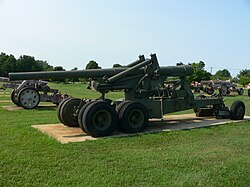This article needs additional citations for verification .(February 2024) |
Long Tom is a generic name for some early age cannon and field guns, used both on land as at sea.



More specifically it was used for:
- 155 mm Long Tom, a U.S. World War II era field gun [1]
- 155 mm Creusot Long Tom, a Boer War field gun
- 64-pounder Long Tom, a U.S. Civil War cannon
- 42-pounder Long Tom, as found on the General Armstrong (1812)
- 24-or 32-pound "Long Tom" cannon, as found on the American USS Hamilton (1809) or Spanish Guerrero
- 18-pound Long Tom, as found on the American privateer Decatur
- Long Tom is the name of the cannon on the Jolly Roger, Captain Hook's ship, in Peter Pan by J. M. Barrie (novel, 1911) [2]